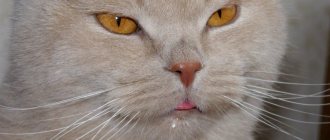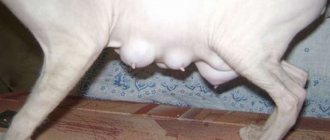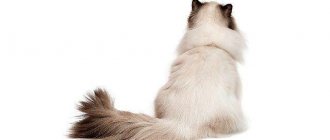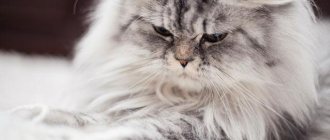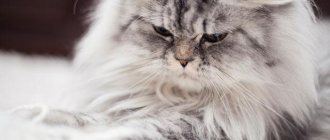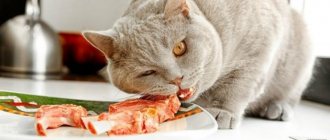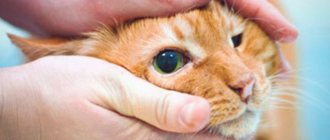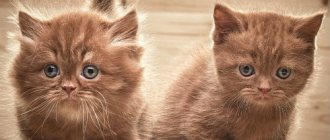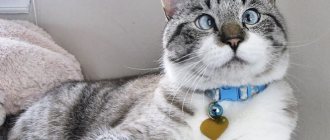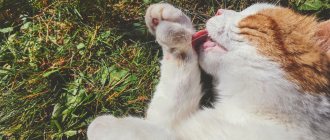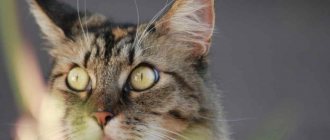Home » Useful Information
Increased salivation in cats can appear for completely harmless reasons, but in some cases the provocateur becomes a pathology that requires mandatory treatment. When such a clinical picture occurs, competent differential diagnosis is important, which will help to identify the disease in the pet at the initial stage.
- 2 Causes of hypersalivation
2.1 The main causes of hypersalivation in cats - video
- 4.1 Drugs that are used to eliminate the causes of hypersalivation - photo gallery
Signs of excessive salivation in cats
Increased salivation (hypersalivation) is not always a sign of pathology. Sometimes this is a reaction to irritation of the taste buds. In this case, the drool is similar in consistency to water and can flow down in a thin stream or drops. The animal constantly swallows and may also wash its face more often. Saliva may be released in large quantities and accumulate in the corners of the mouth, resembling foam. This symptom indicates pathology and occurs with lesions in the mouth. To remove excess saliva, the cat may constantly rub its face against the corners of the furniture.
Increased salivation in a cat is not always a symptom of a disease.
Additional signs of hypersalivation that may indicate disease:
- wet face, neck and, less frequently, front legs;
- poor health or, on the contrary, increased excitability;
- decreased appetite;
- vomiting and diarrhea;
- itching and skin rashes;
- increased body temperature;
- cough;
- constant slurping.
Attention! If your furry friend suddenly starts drooling, you need to monitor his behavior. Even if there are no additional signs, it is important to consult a doctor.
Causes of hypersalivation
Hypersalivation is not a characteristic feature of any particular breed and, under the influence of provoking factors, can occur in all cats. All causes can be roughly divided into 3 categories: physiological, psychological and pathological. Each of them has its own characteristics.
Physiological reasons:
- Changing teeth. This is most often observed in kittens. When baby teeth fall out and permanent teeth grow in their place, this may be accompanied by irritation of the gums, which provokes increased production of saliva.
- Activation of taste buds. Occurs when the cat smells his favorite food, if he is hungry and is preparing to eat. At the same time, more saliva begins to be released. This is also observed in people who imagine the taste of sour lemon.
- Defensive reaction. Some bitter medicines provoke a symptom that is a natural reaction of the body. In this case, such a sign does not require special therapy.
- Tooth loss and wear in older cats. Provokes drooling and bad breath.
Physiological hypersalivation is observed in cats before eating when smelling food
Psychological factors, such as stress and nervous tension, cannot be discounted. Activation of the autonomic nervous system, under the influence of which the production of saliva increases, can be triggered by fear, contact with other animals, moving to a new place, visiting a veterinarian, etc. In this case, the cat may experience shortness of breath and a worsening appetite. The animal often hides in a secluded corner and looks hunted. After eliminating the provoking factor, the pet’s body is restored, and hypersalivation stops.
Stress in a cat can cause active salivation
Pathological factors:
- Oral diseases. These include gingivitis, herpes, periodontitis, etc. In this case, the pet’s gums are swollen, red and bleeding.
- A foreign body, such as a bone, stuck between the teeth or in the throat of an animal. Additionally, your pet may be bothered by a cough and thirst.
- Rabies virus. At the same time, the animal’s behavior changes and photophobia occurs. The pet may become aggressive or, on the contrary, lethargic. Saliva is released in large portions, and the fur falls off.
- Poisoning that can be caused by topical flea chemicals and medications. It is a common cause of hypersalivation. In this case, vomiting, diarrhea and decreased appetite are additionally present. The temperature also often rises.
- Gastritis and ulcerative lesions of the gastrointestinal tract. They can cause a similar clinical picture and are often accompanied by a decrease in appetite and bowel dysfunction.
- Helminthic infestations present in the animal's gastrointestinal tract. In this case, the animal may lose weight.
- Malignant and benign tumors.
- Allergic reaction to food, insect bites and medications. May be accompanied by increased salivation, as well as itching and skin rashes. In this case, it is important to show the cat to a veterinarian.
Lack of activity in a cat, increased salivation and abnormal bowel movements indicate poisoning
Also, one of the serious causes of drooling may be calcivirosis, an infectious disease that can cause lameness, inflammation of the conjunctiva, nose, ulceration of the gums and damage to the respiratory system. If the pathology is not detected in time, a secondary bacterial flora may join, which will provoke pneumonia.
Calcivirosis is characterized by inflammation of the respiratory system and increased salivation
Attention! If hypersalivation is accompanied by additional symptoms, then self-medication can cause a deterioration in the pet’s condition. Active saliva production cannot be ignored. It is important to take your cat to the vet on time to reduce the risk of complications.
The main causes of hypersalivation in cats - video
Pathological factors
A cat's drooling can be caused by diseases - contagious and non-contagious. Hypersalivation accompanies damage to the nervous system in some serious pathologies. The following are contagious:
- Rabies. This is a dangerous disease that can be transmitted to humans and other animals. Symptoms of the pathology: aggressiveness, inadequacy, fear of water and light. Foamy viscous saliva is released from the mouth. With other diseases, the cat's drool is clear. The prognosis for rabies is poor.
- Viral leukemia is an infectious disease that affects the immune and hematopoietic system. Symptoms include stomatitis, gingivitis, loss of teeth; with leukemia, the lymph nodes become enlarged and the cat drools. If the process is advanced, the pet may develop tumors and develop severe anemia. In this case, it is impossible to cure the disease, and therapy is aimed at alleviating the cat’s condition and prolonging its life. The doctor prescribes antibiotics and anticancer drugs.
- Tetanus is a disease that manifests itself in tension and impaired muscle mobility, difficulty moving, spasms, and convulsions. The cat cannot eat because it has difficulty during this process, cannot open its mouth, and drools.
- Respiratory tract infections. Various diseases may cause symptoms such as drooling, sneezing, fever, discharge from the eyes and nose, and mouth ulcers.
Diagnostic methods
Diagnostic methods used to identify the provoking factor:
- Inspection. The doctor determines the condition of the gums, teeth, larynx, and skin. With allergies, rashes are often observed, and the presence of inflammatory processes can be understood by reddened and swollen tissues in the oral cavity. The veterinarian also feels the abdominal cavity. If the pet reacts violently to the procedure, then the presence of gastrointestinal diseases can be suspected.
- Ultrasound. Ultrasound examination is used to identify foreign bodies and tumors in the abdominal cavity. This method is completely safe and painless for the animal.
- Blood, urine and stool tests. An increase in leukocytes and red blood cells in plasma indicates an inflammatory process. Also, such deviations may indicate the presence of tumors. Protein can be detected in the urine, indicating a malfunction of the urinary system, an inflammatory process, as well as salts, the increase of which indicates the presence of kidney stones. Bacteria present during an infectious process may be found in urine. Stool analysis is necessary to identify helminthic infestations.
- MRI. Magnetic resonance imaging is an expensive research method, thanks to which it is possible to determine disturbances in the functioning of internal organs, as well as the presence of tumor processes. This procedure requires preliminary sedation (injection of sleeping pills) of the pet so that it does not move or run away during the examination.
Ultrasound allows you to identify pathologies of the pet’s internal organs
An integrated approach to diagnosis allows you to obtain an accurate result based on a number of studies. In this case, pathology can be detected in the early stages of development.
Treatment of pathologies associated with the symptom
If increased salivation is caused by physiological factors, then no special treatment is provided. Psychological and pathological causes require mandatory therapy. What treatment methods are used depending on the factor:
- If the cause is nervous overstrain, cats are usually prescribed sedative medications: Stop Stress, Fitex, etc. Such drugs help eliminate the effects of stress. The course of treatment often does not exceed 7–14 days. Stop Stress is usually given 1 tablet per day or 1 drop per 1 kg of weight, and Fitex 3-5 drops per day. The exact dose is determined by the doctor. In addition, it is important to provide the pet with peace and surround it with affection and care.
- For diseases of the oral cavity, anti-inflammatory drugs are used, such as Dentavedin gel, Zubastik spray, etc. These drugs eliminate swelling of the gums and have an antiseptic and healing effect. Gel Dentavedin contains bee products, chlorhexidine and medicinal plants. It should be applied 2-3 times a day to the gums for 5-7 days. Zubastic spray also contains plant extracts and an enzyme anti-inflammatory complex. The medicine is irrigated into the mouth several times a day for a week.
- If a cat has a bone or other foreign object stuck in its throat or teeth, it must be removed in a veterinary clinic. For these purposes, the doctor can use tweezers or an endoscope. Immediately after removing the foreign body, hypersalivation stops. It is dangerous to independently remove a bone stuck in the larynx, as you can push it further or injure your pet (especially when using tweezers).
- If the cause is the rabies virus, which was diagnosed in the laboratory, then, unfortunately, the pet is euthanized. This disease is incurable and dangerous not only for animals, but also for people. Therefore, if rabies is suspected, the cat is quarantined until a diagnosis is made.
- In case of poisoning, the pet is prescribed adsorbents such as activated carbon. The tablet must be crushed into powder and dissolved in 1 tsp. water, then forcefully pour it into your pet’s mouth. However, if the intoxication is severe, then urgent hospitalization is required, which includes gastric lavage. In addition to adsorbents, the animal should be given 20 ml of water every hour from a syringe without a needle if it does not drink on its own. This procedure will prevent dehydration.
- If the provoking factor for hypersalivation is helminthic infestations, anti-helminth medications are prescribed, such as Prazicide, Drontal, etc. In most cases, a single application is enough to rid your furry friend of parasites. The dose should be calculated based on the cat's body weight.
- The presence of tumors requires treatment only in a hospital setting. In this case, they resort to surgical intervention, which is aimed at excision of the tumor. Additionally, medications may be prescribed: Metastop, Cytostat, etc. The first drug prevents the growth of tumors and reduces the risk of metastases, and also has an antitoxic effect. Cytostat improves the overall well-being of the pet. Additionally, it has an antioxidant and antitoxic effect, accelerating recovery.
- If the provocateur of increased salivation is an allergic reaction, then drug therapy is prescribed. For anaphylactic shock, glucocorticosteroids are indicated. They are also used for severe allergic reactions, which are accompanied by severe itching. The most commonly prescribed drugs are Dexamethasone and Prednisolone, which are administered intramuscularly. A single dose ranges from 0.1 to 0.5 ml. The exact amount of solution and course are determined only by the doctor, since steroid drugs can cause dangerous side effects.
- To eliminate mild allergy symptoms, classic antihistamines are used: Suprastin, Zodak, Cetirizine, etc. They are usually given to the pet orally, a quarter of a tablet, once a day. The course is determined by the doctor. It is important to identify the allergen and eliminate it. Otherwise, after stopping therapy, the symptoms will return again.
- Calcivirosis can be eliminated with the help of complex treatment. When bacterial flora attaches, which happens in most cases, the pet is prescribed antibiotics (Tetracycline, Amoxicillin). Additionally, they resort to intravenous infusion of physiological solutions, as well as vitamin therapy. Anti-inflammatory medications such as Levomekol are used. The ointment is applied to the affected areas several times a day. To speed up recovery, immunostimulants are prescribed: Imunofan, Fosprenil, etc. The course of treatment depends on the severity of symptoms and is determined only by a doctor.
If the cause is inflammatory diseases of the gastrointestinal tract, then the cat is prescribed a gentle diet. Your pet's diet should be free of fatty, smoked and salty foods. At the same time, food is selected for sensitive digestion. It is advisable to give preference to reputable brands such as Royal Canin, Arden Grange, Pro Plan, etc. There are special lines for pets with digestive problems:
- Royal Canin Sensible 33;
- Arden Grange Sensitive;
- Pro Plan Delicate.
Royal Canin Sensible 33 is designed for pets with sensitive digestion
Attention! Without prior consultation with a doctor, you should not resort to drug therapy, especially potent drugs, which, if used incorrectly, can only cause harm.
My cat always drooled after I gave her any medicine. At first it seemed to me that the drug was toxic, which is why I had this reaction. I thought that I only made the pet worse with this treatment. It turns out that increased salivation is a normal reaction to bitters in cats. Hypersalivation is also observed when you squeeze and pet an animal excessively. According to the veterinarian, there is nothing wrong with this.
Drugs that are used to eliminate the causes of hypersalivation - photo gallery
Stop Stress has a calming effect
Activated carbon helps remove and bind toxic substances Drontal helps remove helminths
Dexamethasone eliminates acute allergic reactions Zodak relieves allergy symptoms Metastop has antitumor properties Dentavedin has an anti-inflammatory effect
Fosprenil accelerates recovery from calcivirosis
Veterinarian consultation
The owner should tell the doctor in detail about how the cat spent the last few days. It is important what kind of appetite the pet had, whether its behavior and appearance changed.
The veterinarian will ask about vaccinations, medications used, and possible toxins.
After this, the doctor will determine where and how the pet will be treated. Depending on the diagnosis, therapy is possible at home or in a hospital.
Preventive actions
How to prevent hypersalivation in your pet:
- monitor the condition of your gums. Brush your pet’s teeth with a special brush 2 times a week, and also examine the oral cavity for the presence of inflammatory processes;
- try to protect your cat from stress;
- do not give the animal fish with bones;
- feed your pet only high-quality food;
- keep household chemicals away, do not leave bleach, building materials, etc. open;
- avoid contact of the cat with street animals;
- Give your pet anti-worm medications once every 3 months;
- when removing fleas, make sure that the cat does not lick the preparation intended for topical use;
- do not give the animal any medications without first consulting a doctor;
- Be sure to give your cat all the necessary vaccinations;
- Take your pet to the veterinarian once every 6 months. After all, only a specialist can recognize minor deviations from the norm at the initial stages.
To prevent hypersalivation and inflammatory processes, your cat’s teeth should be brushed 2 times a week.
Attention! If the animal is often outside, then you need to bathe it once every 2 weeks. It is important to check your pet for fleas, which are carriers of helminths and various diseases.
To prevent increased salivation in the cat, as well as dangerous consequences for the gastrointestinal tract, I tried not to give my pet fish with bones. My favorite loved this product and even tried to steal the herring right from the table, but I either refused the cat such a delicacy, or first cleaned the fish from the bones. I also tried to feed my pet only high-quality products.
The cat is drooling, clear as drops of water: what is he talking about?
Regardless of the etiology, ptyalism in the initial stages is characterized by colorless, light discharge. The exception is rabies, which produces foam.
Breeders try to diversify the diet as much as possible so that the furry friend receives all the necessary nutrients, vitamins, and minerals. An unpleasant manifestation can be caused by a bone getting stuck in the gum or palate.
Trauma to the oral mucosa may also be the cause. When a foreign body is stuck or injured, the predator eats only on one side. Tries to remove the irritating bone with his paw.
If your jaw is dislocated, it is difficult for your pet to eat and drink. He makes hysterical sounds and sticks his tongue out to one side. Similar manifestations are observed with stinging insect bites. It is necessary to remove the poisonous sting (if any) and give an antihistamine to prevent swelling of the larynx.
Animals are often taken to the sea. Apartment cats, not accustomed to the scorching sun, receive the gift of heat.
Young kittens are active and playful. The etiological factor of hypersalivation can be a concussion as a result of a blow from a fall from a height.
